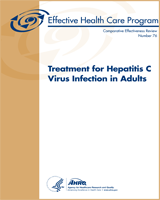NCBI Bookshelf. A service of the National Library of Medicine, National Institutes of Health.
Chou R, Hartung D, Rahman B, et al. Treatment for Hepatitis C Virus Infection in Adults [Internet]. Rockville (MD): Agency for Healthcare Research and Quality (US); 2012 Nov. (Comparative Effectiveness Reviews, No. 76.)
Individual studies were rated as “good,” “fair” or “poor”:
For Controlled Trials:
Each criterion was give an assessment of yes, no, or unclear.
- Was the assignment to the treatment groups really random?
- Adequate approaches to sequence generation:
- Computer-generated random numbers
- Random numbers tables
- Inferior approaches to sequence generation:
- Use of alternation, case record numbers, birth dates or week days
- Randomization reported, but method not stated
- Not clear or not reported
- Not randomized
- Was the treatment allocation concealed?
- Adequate approaches to concealment of randomization:
- Centralized or pharmacy-controlled randomization (randomization performed without knowledge of patient characteristics).
- Serially-numbered identical containers
- On-site computer based system with a randomization sequence that is not readable until allocation
- Sealed opaque envelopes
- Inferior approaches to concealment of randomization:
- Use of alternation, case record numbers, birth dates or week days
- Open random numbers lists
- Serially numbered non- opaque envelopes
- Not clear or not reported
- Were the groups similar at baseline in terms of prognostic factors?
- Were the eligibility criteria specified?
- Were outcome assessors and/or data analysts blinded to the treatment allocation?
- Was the care provider blinded?
- Was the patient kept unaware of the treatment received?
- Did the article include an intention-to-treat analysis, or provide the data needed to calculate it (i.e., number assigned to each group, number of subjects who finished in each group, and their results)?
- Did the study maintain comparable groups?
- Did the article report attrition, crossovers, adherence, and contamination?
- Is there important differential loss to followup or overall high loss to followup?
For Cohort Studies:
Each criterion was give an assessment of yes, no, or unclear.
- Did the study attempt to enroll all (or a random sample of) patients meeting inclusion criteria, or a random sample (inception cohort)?
- Were the groups comparable at baseline on key prognostic factors (e.g., by restriction or matching)?
- Did the study use accurate methods for ascertaining exposures, potential confounders, and outcomes?
- Were outcome assessors and/or data analysts blinded to treatment?
- Did the article report attrition?
- Did the study perform appropriate statistical analyses on potential confounders?
- Is there important differential loss to followup or overall high loss to followup?
- Were outcomes pre-specified and defined, and ascertained using accurate methods?
- Quality Assessment Methods - Treatment for Hepatitis C Virus Infection in AdultsQuality Assessment Methods - Treatment for Hepatitis C Virus Infection in Adults
Your browsing activity is empty.
Activity recording is turned off.
See more...
